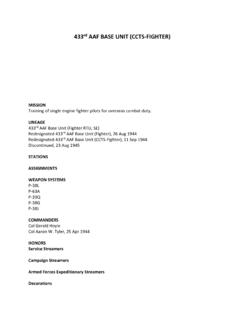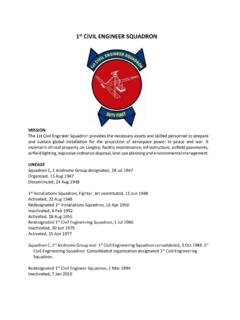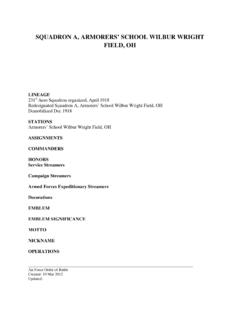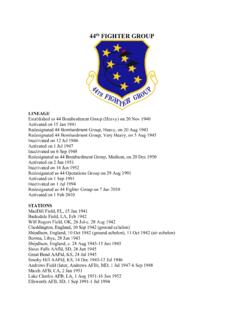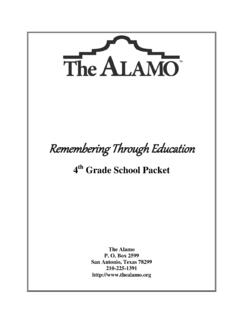Transcription of 31 TEST AND EVALUATION SQ - USAF LINEAGE AND HONORS
1 31st TEST AND EVALUATION SQUADRON MISSION The 31st Test and EVALUATION Squadron is located at Edwards Air Force Base, Calif., with an operating location at Gray Butte, Calif. The squadron evaluates the operational effectiveness and suitability of advanced ACC weapon systems by providing operations, maintenance and engineering experts to work alongside Air Force Materiel Command and Air Force Operational Test and EVALUATION Center personnel. Current operational test and EVALUATION programs involve the B-52, B-1, B-2, F-22 Joint Strike Fighter, RQ-4 Global Hawk, MQ-9 Reaper, and the Airborne Laser.
2 Squadron personnel integrate live test results with modeling and simulation data to predict combat capabilities under realistic scenarios, setting the stage for the development of new Combat Air Force tactics. Results and conclusions support DoD acquisition, deployment and employment decisions. LINEAGE 31st Aero Squadron organized, 13 Jun 1917 Demobilized, 14 Apr 1919 Reconstituted and redesignated 31st bombardment Squadron, 24 Mar 1923 Activated, 1 Apr 1931 Redesignated 31st bombardment Squadron (Medium), 6 Dec 1939 Redesignated 31st bombardment Squadron ( heavy ), 20 Nov 1940 Redesignated 31st bombardment Squadron, heavy , 6 Mar 1944 Redesignated 31st bombardment Squadron, very heavy , 30 Apr 1946 Inactivated, 10 Mar 1947 Redesignated 31st Reconnaissance Squadron, very Long Range, Photographic, 16 Sep 1947 Activated, 20 Oct 1947 Redesignated 31st Reconnaissance Squadron, very Long Range, Photo, RCM, 23 Dec 1947 Redesignated 31st Strategic Reconnaissance Squadron, Photographic, 16 Jun 1949 Redesignated 31st Strategic Reconnaissance Squadron, heavy , 16 Nov 1950 Redesignated 31st bombardment Squadron, heavy .
3 1 Oct 1955 Discontinued and inactivated, 1 Feb 1963 Redesignated 31st Test and EVALUATION Squadron, 12 Feb 1986 Activated, 1 Jul 1986 STATIONS Camp Kelly, TX, 13 Jun-11 Aug 1917 Etampes, France, 19 Sep 1917 Issoudun, France, 23 Sep 1917 Bordeaux, France, 6 Jan-18 Mar 1919 Mitchel Field, NY, 5-14 Apr 1919 March Field, CA, 1 Apr 1931 Hamilton Field, CA, 5 Dec 1934 Hickam Field, TH, 8 Feb 1938 Kipapa, TH, 23 May 1942 Kualoa, TH, 9 Sep-9 Nov 1942 Espiritu Santo, 30 Nov 1942 Guadalcanal, 17 Jan 1943 (operated from Munda, New Georgia, 2 Feb-13 Mar 1944) Momote Airfield, Los Negros, 20 Apr 1944 Wakde, 20 Aug 1944 Noemfoor, 26 Sep 1944 Morotai, 16 Oct 1944 Samar, 17 Mar 1945 Clark Field, Luzon, Dec 1945-10 Mar 1947 Yokota AB, Japan, 20 Oct 1947 Kadena Field, Okinawa, 16 Mar 1949 Yokota AB, Japan, 12 Jul 1950 Johnson AB, Japan, 14 Aug-16 Nov 1950 Travis AFB, CA, 16 Nov 1950 Beale AFB, CA, 18 Jan 1960-1 Feb 1963 Edwards AFB, CA, 1 Jul 1986 ASSIGNMENTS Unkn, 13 Jun-Sep 1917 Third Aviation Instruction Center, Sep 1917-Jan 1919 Unkn, Jan-14 Apr 1919 7th bombardment Group, attached on 1 Apr 1931, assigned on 30 Jun 1931 5th Composite (later.)
4 5th bombardment ; 5th Reconnaissance) Group, 1 Feb 1938-10 Mar 1947 71st Reconnaissance Group, 20 Oct 1947 Fifth Air Force (attached to 71st Reconnaissance Group), 18 Aug 1948 Thirteenth Air Force, 16 Mar 1949 311th Air Division, 1 Apr 1949 Second Air Force, 1 Nov 1949 5th Strategic Reconnaissance Group, 1 Dec 1949 5th Strategic Reconnaissance (later, 5 bombardment ) Wing, 16 Jun 1952 4126th Strategic Wing, 1 Oct 1959-1 Feb 1963 Strategic Air Command, 1 Jul 1986 USAF Air Warfare Center, 1 Jun 1992 79th (later, 53rd) Test and EVALUATION Group, 15 Apr 1993 ATTACHMENTS Far East Air Forces, Dec 1949-16 Nov 1950 5th Strategic Reconnaissance Wing, 10 Feb 1951-15 Jun 1952 5th bombardment Wing, 2 Oct 1959-18 Jan 1960 WEAPON SYSTEMS B-3A B-4A O-19B O-38B B-10B Y1B-4 YB-12A B-12 B-12A B-17E B-29A B-52G COMMANDERS Cpt Earle G.
5 Harper, 1 Apr 1931 Cpt Devereaux Myers, 14 Oct 1931 Cpt Earle G. Harper, 2 Nov 1931 Cpt Harold W. Beaton, 1 Dec 1931 1Lt Ralph A. Snavely, 29 Jun 1932 Maj Harold D. Smith, 6 Jan 1934 Maj James G. Taylor, 16 Nov 1936 Cpt Walter R. Agee, 11 Jan 1939 Cpt Hugh F. McCaffery, 6 Mar 1940 Cpt Russell L. Waldron, 4 Mar 1941 LTC Rhudy, 23 Dec 1941 Maj Carmichael, 2 Feb 1942 2 Cpt Blakey, 10 Feb 1942 Maj Rutledge, 24 Mar 1942 Maj George Glober, 21 Jun 1942 Maj Francis T. Brady, 30 Mar 1943 Maj Morris W. Slack, 17 Jun 1943 LTC Joseph Reddoch, 6 Aug 1943 Maj John F. Britton, 4 Sep 1943 Maj Francis E.
6 Riggs, 10 Dec 1943 Maj John Henry Kissner, 31 Dec 1943 Cpt William Fallin, 28 May 1944 Cpt George T. Davis, 28 Jul 1944 Maj Everett Rowe, 5 Jan 1945 Cpt Everett Thurlow, 4-26 Apr 1945 LTC Earle L. Hehn, Jr. LTC Fred S. Hodges HONORS Service Streamers World War I Theater of Operations Campaign Streamers World War II Central Pacific 1941-1943 Guadalcanal 1942-1943 New Guinea 1943-1944 Northern Solomons 1943-1944 Eastern Mandates 1943-1944 Bismarck Archipelago 1943-1944 Western Pacific 1944-1945 Leyte 1944-1945 Luzon 1944-1945 Southern Philippines 1945 China Offensive 1945 Air Combat, Asiatic-Pacific Theater 1941-1945 Korea.
7 UN Defensive 1950 UN Offensive 1950 CCF Intervention 1950-1951 Armed Forces Expeditionary Streamers None Decorations Distinguished Unit Citations Woleai Island, 18 Apr-15 May 1944 Borneo, 30 Sep 1944 Presidential Unit Citation (Navy) [1942] Air Force Outstanding Unit Awards 1 Jul 1985-30 Jun 1987 1 Jun 1988-30 Jun 1990 1 Jul 1990-29 May 1992 30 May 1992-29 May 1994 1 Jun 1994-31 May 1996 1 Jun 1998-31 May 2000 Philippine Presidential Unit Citation (WWII) Republic of Korea Presidential Unit Citation 7 Jul-[16 Nov 1950] EMBLEM 31st Test and EVALUATION Squadron 31st Test and EVALUATION Squadron emblem: On a disc Azure, a triangle Sable fimbriated Argent point to chief charged with a skull and crossbones of the last, all within a narrow border Or.
8 Attached below the disc, a Blue scroll edged with a narrow Yellow border and inscribed 31 TES in Yellow letters. Ultramarine blue and Air Force yellow are the Air Force colors. Blue alludes to the sky, the primary theater of Air Force operations. Yellow refers to the sun and the excellence required of Air Force personnel. The skull and crossbones in the triangle represent a warning to the enemy to beware. (Approved on 10 Sep 1934 and revised on 9 Mar 1995) MOTTO NICKNAME OPERATIONS On 26 June 1917 the 31st Bomb Squadron came into being. It was organized as the 31st Aero Squadron at Kelly Field Texas, under the command of First Lieutenant John E.
9 Rossel. The personnel strength was built around a nucleus from the First Company, "B" Provisional Battalion, of the Signal Corps; which had been activated the month before. After a scant two months of training, a Captain Carl Spatz was placed in command of the squadron and sealed orders transferred the organization from Kelly Field to an unannounced destination. On 15 September 1917 the Squadron arrived in England and began intensive training in the intricate ways of war-making. In England air and ground personnel of the 31st wound up three rigorous months of training and reassembled in Issodum, France, in December of 1917.
10 And it was on this move that this Squadron began its long string of "Firsts", the 31st being one of the first aero squadrons to arrive in France in 1917. The 31st spent over a year and a half in France. They were assigned 15 Meter French Nieuports to fly, one of the most difficult airplanes of the last war to maintain and fly. Under the most adverse conditions they kept these planes in the air just as their sons are doing now a quarter of a century and a half a world apart. The 31st moved to Field 5 on January 18th, 1918. They were assigned the maintenance of aircraft. Here they built barracks and hangars and reached 100 percent efficiency, a record they would maintain throughout the entire war.


